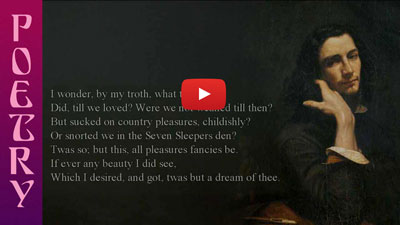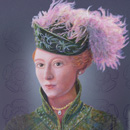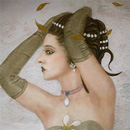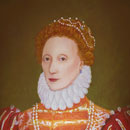A love poem from the 17th century
Transcript - The Good-Morrow
I wonder, by my troth, what thou and I
Did, till we loved? were we not weaned till then?
But sucked on country pleasures, childishly?
Or snorted we in the Seven Sleepers' den?
'Twas so; but this, all pleasures fancies be.
If ever any beauty I did see,
Which I desired, and got, 'twas but a dream of thee.
And now good morrow to our waking souls,
Which watch not one another out of fear;
For love, all love of other sights controls,
And makes one little room an everywhere.
Let sea-discoverers to new worlds have gone,
Let maps to others, worlds on worlds have shown,
Let us possess one world, each hath one, and is one.
My face in thine eye, thine in mine appears,
And true plain hearts do in the faces rest;
Where can we find two better hemispheres,
Without sharp North, without declining West?
Whatever dies was not mixed equally;
If our two loves be one, or, thou and I
Love so alike that none do slacken, none can die.
Did, till we loved? were we not weaned till then?
But sucked on country pleasures, childishly?
Or snorted we in the Seven Sleepers' den?
'Twas so; but this, all pleasures fancies be.
If ever any beauty I did see,
Which I desired, and got, 'twas but a dream of thee.
And now good morrow to our waking souls,
Which watch not one another out of fear;
For love, all love of other sights controls,
And makes one little room an everywhere.
Let sea-discoverers to new worlds have gone,
Let maps to others, worlds on worlds have shown,
Let us possess one world, each hath one, and is one.
My face in thine eye, thine in mine appears,
And true plain hearts do in the faces rest;
Where can we find two better hemispheres,
Without sharp North, without declining West?
Whatever dies was not mixed equally;
If our two loves be one, or, thou and I
Love so alike that none do slacken, none can die.
Background - a brief biography of the poet John Donne

● John Donne was born in England in 1572, and died in 1631. His family was Catholic at a difficult time following the upheaval of the Reformation and counter-Reformation.
● A lawyer by profession, he also became a member of parliament. But his career was dogged by the prevailing anti-Catholic sentiment of the times, and eventually he converted to the Anglican faith.
● He married in 1601 under somewhat controversial circumstances - facing disapproval from his father-in-law. It was, in fact, a happy marriage, but his wife, Anne, though younger, did not survive him and she died shortly after the birth of their 12th child.
● A lawyer by profession, he also became a member of parliament. But his career was dogged by the prevailing anti-Catholic sentiment of the times, and eventually he converted to the Anglican faith.
● He married in 1601 under somewhat controversial circumstances - facing disapproval from his father-in-law. It was, in fact, a happy marriage, but his wife, Anne, though younger, did not survive him and she died shortly after the birth of their 12th child.
● With increasing enthusiasm for his adopted faith, he became Dean of London’s St Paul’s Cathedral in 1621.
● Although his verse often focuses on metaphysical issues, it can also be highly Romantic in nature. It draws upon the cultural changes prevalent in English society at the time - geographical expansion, new worlds of discovery, new ideas and theories of humanity’s place in the universe. The poem featured here is a good example of the effects these developments had on the way people thought.
● Although his verse often focuses on metaphysical issues, it can also be highly Romantic in nature. It draws upon the cultural changes prevalent in English society at the time - geographical expansion, new worlds of discovery, new ideas and theories of humanity’s place in the universe. The poem featured here is a good example of the effects these developments had on the way people thought.
The Good-Morrow, insights, themes and ideas for interpretation
● The poem describes a greeting between the poet and his lover, an early-morning moment of togetherness and mutual regard.
● To paraphrase from what might seem at the outset to be quite challenging 17th-century verse, the poet is drawing upon various strands of symbolism and popular wisdom to emphasise the oneness that can exist between separate, often opposite forces of nature.
● Love, as experienced by the poet at this moment, is perceived as a perfect example of this ‘oneness’ - a redeeming, ennobling state, particularly when compared to the lustful immaturities of the poet’s past. But in so doing he is perhaps also suggesting that even these two disparate forces, the devotional and the erotic, can be reconciled.
● Jealousy and fear are overcome, therefore, because true love is so strong that it can regulate and accommodate temptations or wayward tendencies even among those who might stray.
● All these qualities are best when mixed equally, and through a state of harmony between lovers a measure of immortality and eternal existence might be possible. This is why the piece is sometimes termed ‘a metaphysical’ or ‘a mystical poem’ - because its message transcends the world of physical experience. A wonderful poem and definitely ‘food for thought.’
● To paraphrase from what might seem at the outset to be quite challenging 17th-century verse, the poet is drawing upon various strands of symbolism and popular wisdom to emphasise the oneness that can exist between separate, often opposite forces of nature.
● Love, as experienced by the poet at this moment, is perceived as a perfect example of this ‘oneness’ - a redeeming, ennobling state, particularly when compared to the lustful immaturities of the poet’s past. But in so doing he is perhaps also suggesting that even these two disparate forces, the devotional and the erotic, can be reconciled.
● Jealousy and fear are overcome, therefore, because true love is so strong that it can regulate and accommodate temptations or wayward tendencies even among those who might stray.
● All these qualities are best when mixed equally, and through a state of harmony between lovers a measure of immortality and eternal existence might be possible. This is why the piece is sometimes termed ‘a metaphysical’ or ‘a mystical poem’ - because its message transcends the world of physical experience. A wonderful poem and definitely ‘food for thought.’
Technical info’
Type of Poem =
though sometimes termed a 'sonnet,' the poem is very unlike most regular sonnet forms, being in this instance 3 stanzas of 7 lines each.Rhyme Scheme =
AB AB CCCMeter =
mostly iambic pentameter (that is 5 pairs of unstressed and stressed syllables per line) but concluding each stanza in iambic hexameter (six pairs of unstressed and stressed syllables per line)Georgian novel
Tudor Novel
Victorian Gothic
Fictional Memoir















